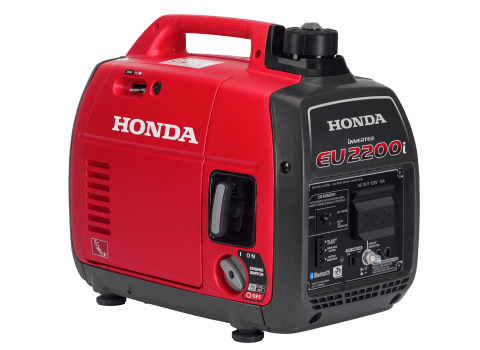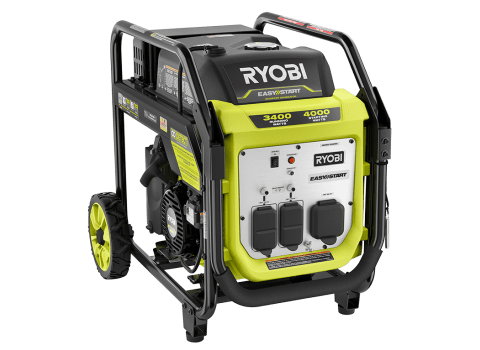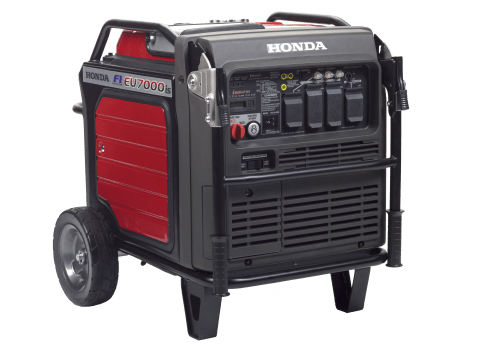How to Choose the Right Size Generator
CR's experts help you find the best model for backup power when the lights go out

By Paul Hope, Tobie Stanger
When there’s an unplanned power outage in your home, you can face a long list of inconveniences and expenses, including spoiled food, frozen pipes, flooded basements, and moldy walls. And when it goes on for days or weeks—which can happen after a major weather disaster—the pain only gets worse.
Indeed, one major blackout might be enough to prompt you to buy a generator.
That wouldn’t be such a bad idea. Americans could see more blackouts and brownouts in the years ahead, trends suggest. The U.S. Energy Administration says the typical American endures an average of 8 hours without power each year because of unplanned outages—double the number in 2013.
A generator is a first line of defense against these problems, but choosing one can be daunting. Models range from small recreational units that start at about $450 and can power a single appliance to standby models—sometimes called a whole-house or home standby generator—that can cost $5,000 or more and power an entire house.
How do you figure out which type or size generator is right for your needs? Keep reading.
Factors to Consider
To determine the size generator you need, consider the appliances you need to power and add up their wattage, advises Misha Kollontai, the Consumer Reports engineer who handles generator testing. But if you’re considering a portable generator, don’t spend more on one that produces more power than you need for those appliances, he adds.
“There’s no need to go larger unless you want to be able to power more in a pinch and are comfortable with needing to keep more gas on hand,” Kollotai says. Some of the larger portable generators in our ratings can burn through about 20 gallons of gasoline per day.
Depending on the size generator you need, you may have a choice between a traditional portable generator and an inverter generator, which electronically throttles the engine up and down to supply power more efficiently. Inverter generators are more expensive than traditional generators delivering the same wattage, but have distinct advantages.
“If you’re willing to pay more up front for a quieter and more fuel-efficient unit, potentially saving down the road if you use it often, then look at inverters,” Kollontai says.
Here, we offer guidance on how to choose the generator that’s right for your situation, along with details on each category of generator we test and a CR recommendation and product review in each category.
A Word on Wattage
One way to answer the question of which size generator you need is to add up the wattages of everything you want to power during an outage. That will give you a rough approximation. But before you bust out the calculator, keep in mind that some appliances—air conditioners, refrigerators, and sump pumps, for instance—draw a lot more wattage at the moment they’re cycling on. These surge watts can throw off your calculations if you don’t account for them.
We’ve done that for you in the interactive tool below. Just click on a type of generator to get a sense of what you can run with it. The wattages for each type of appliance are general guidelines and may vary from what you have in your home.
Another way to think about choosing the right size generator for your home is to consider how often you’re likely to need one—and for how long. That’s unpredictable to an extent, of course, but think about what you’ll need to power and see which of the three power-outage scenarios below match your situation.
You can click on any type to jump down to a list of its pros and cons, as well as a specific product recommendation and review for each.
1. You Experience Frequent Power Outages
Even worse, the outages are sometimes prolonged. This also applies if you live in an area prone to severe weather events, such as blizzards, ice storms, tornadoes, and hurricanes.
Generator Types to Consider
• Home standby
• Large inverter
• Large portable
These three types have enough juice to power your entire household, and they can connect directly to your home’s circuit breaker panel, allowing you to control and run appliances that are hardwired, such as central heat and air conditioning, well pumps, sump pumps, electric ranges, and water heaters. If you have any of these and it’s essential for them to work in a power outage, be sure to have a transfer switch installed at your breaker box. A licensed electrician should be able to handle the job.
2. You Have Occasional Outages
Sometimes they’re sustained, but not typically, and you don’t want to spend thousands on a home standby generator.
Generator Types to Consider
• Large inverter
• Large portable
Unless you experience numerous power outages a year, you may not be willing to spring for the $10,000 or more it can cost to buy a stationary unit and have it installed. You can save thousands of dollars if you don’t mind having to pull your large inverter or portable generator out of a garage or shed and hook it up during the outage. You’ll still want to have a transfer switch installed.
3. You Rarely Lose Power
Even so, you want a generator for some peace of mind.
Generator Types to Consider
• Midsized inverter
• Small, recreational inverter
Midsized inverter generators have ample power to run a fridge and a window AC or space heater, as you can see in our interactive tool. Small, recreational models are compact enough to toss into the back of a pickup to power a TV and cooktop at a tailgate. Go Wildcats!
Safety First
Consumer Reports recommends only portable generators with CO safety technology—that is, a built-in sensor that triggers an automatic shutoff if carbon monoxide builds up to dangerous levels in an enclosed space. (CR no longer tests generators without this feature; the older models in our ratings that lack it earn a Poor score for CO safety technology.)
With any generator, it’s extremely important to follow our long-standing advice of always operating a generator a minimum of 20 feet from your home with the exhaust directed away from it as well as from any windows, doors, AC units, or other structures.
Small, Recreational Inverter Generator
Up to around 2,000 watts
$450–$1,600
Pros: Small inverter generators are the lightest type of generator (most models weigh around 60 pounds). They are extremely quiet, have no installation costs, and are easy to store and transport. You can pair most units to increase output. Many come with user-friendly features such as fuel-level indicators and smartphone apps.
Cons: These generators are enough to power a fridge, some lights, and a phone charger, but not much else. They can’t be connected to a circuit breaker panel or used to power any device that doesn’t have a standard plug. The most expensive models cost as much as a portable generator, which can do far more.
Honda EU2200iTAG

The small, portable Honda EU2200iTAG inverter generator is the best in its class. It’s reliable and produces high-quality power, without distortion, earning a rating of Excellent for power quality. That’s important to avoid frying sensitive electronics, such as a charging smartphone. It’s quiet and produces 1,800 watts. It has a CO safety shutoff, plus it’s designed to produce lower CO emissions.
Midsized Inverter
2,000 to around 3,500 watts
$800–$2,400
Pros: Midsized inverter generators are lightweight (most models weigh less than 150 pounds) and quiet. They’re also efficient, capable of keeping the fridge running and the lights on for 8 to 25 hours using only 2 to 3 gallons of gas.
Cons: These inverter generators can generally power only 110-volt items with a standard two- or three-prong plug, ruling out well pumps, and heating and cooling equipment. You can now find special 110-volt transfer-switch kits, but the installation cost makes them an impractical choice because you could opt for a portable generator with a 220-volt transfer switch for the same amount.
Ryobi RYi4022X

This modestly priced inverter model from Ryobi offers stellar performance all-around, including ratings of Excellent for power delivery and power quality. Its listed capacity is 3,400 watts, but it can reach 4,000 watts in the event of a surge, as when an appliance starts up. It has an electric start and a CO safety shutoff. It runs up to 23 hours on a single tank of gas.
Large Portable
Up to 8,500 watts
$950–$2,000
Pros: Portable generators are the best value in terms of cost vs. capacity. Certain large models produce enough energy to meet all the power demands in a home. They can be connected to a breaker panel with a transfer switch to run hardwired equipment, such as a well pump.
Cons: Making the connection to your home’s circuit breaker panel costs as much as the generator itself. They’re noisier than large inverter generators and home standby generators. They usually run only on gasoline and use a lot of it compared with inverters. And they’re bulky; most weigh around 250 pounds. They shouldn’t be used in rain or snow without protection, such as an open-sided tent.
Generac XT8500EFI

This Generac is unmatched in terms of performance and output. It offers an impressive 8,500 watts of power, more than any other portable model in our ratings, and it excels in our crucial tests, earning ratings of Excellent for both power delivery and power quality. It has five outlets and an electric start, as well as an automatic CO safety shutoff.
Large Inverter
5,000 watts to around 7,500 watts
$1,400–$8,000
Pros: Large inverter generators produce enough energy to run a refrigerator, lights, and other essentials, such as a furnace or small central air-conditioning unit. They can be connected to your breaker panel to run hardwired equipment, such as a well pump. They’re quiet and produce steady power, which is ideal for sensitive electronics, such as stereo equipment. And they’re fuel-efficient.
Cons: They’re expensive. Only models costing $2,400 or more perform well enough in our tests to warrant serious consideration. And they can’t run on natural gas or propane, so you still need to keep stabilized gasoline on hand.
Honda EU7000is with CO-MINDER

The Honda EU7000is with CO-MINDER is the top-rated large inverter generator. It’s quiet, efficient, capable, and easy to move and use. It has an electric start and a low-oil shutoff, which stops the engine to avoid damage if the oil level drops too low. It also has a CO safety shutoff. It’s very pricey, though, so also consider the CR-recommended Predator 9500 with CO SECURE, $2,300; it earns Excellent scores for power quality and delivery, but isn’t rated as well for noise or for its CO safety technology.
Home Standby
Up to 20,000 watts
$2,000–$6,000
Pros: Home standby generators are permanently installed (usually next to the house) and kick on automatically during an outage to provide uninterrupted current. They can power everything in a typical home simultaneously, up to their maximum output. Standby generators can be set up to run indefinitely on natural gas or can be fueled by propane. There’s no need to connect cables, flip a switch, or start the engine.
Cons: With few exceptions, standby generators are more expensive than other types of generators. Installation costs can run into the thousands—and those costs are not included in the price range we list above. They can’t be installed in low-lying areas prone to flooding, and can’t be moved in the event of a flood.
Champion 100179

This top-of-the-line standby generator is whisper-quiet and effortlessly aces tests for delivering steady, reliable current. It can power an entire house with ease.
Generator Tips
Damaging storms can happen anytime. On the "Consumer 101" TV show, host Jack Rico learns from Consumer Reports’ expert Paul Hope how to avoid being left in the dark during a power outage.
More from Consumer Reports:
Top pick tires for 2016
Best used cars for $25,000 and less
7 best mattresses for couples
Consumer Reports is an independent, nonprofit organization that works side by side with consumers to create a fairer, safer, and healthier world. CR does not endorse products or services, and does not accept advertising. Copyright © 2022, Consumer Reports, Inc.
